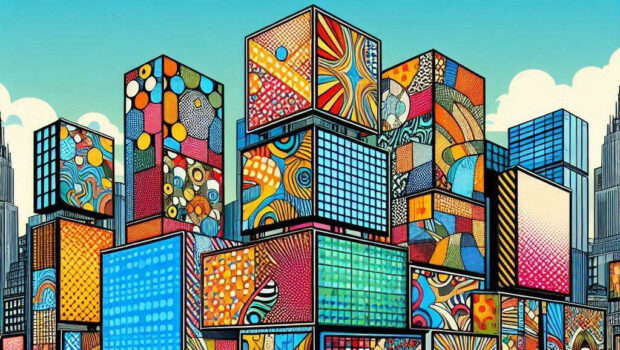How Tech is Turbocharging Transformation in OOH
by on 1st Oct 2024 in News

From marketers giving life to memorable campaigns by harnessing CGI to how AI enhances targeting for outdoor media, we examine the ways evolving technologies have been transforming the OOH industry.
A world of endless possibilities
The past few years have shown us that the possibilities of creativity are endless when the right technology is harnessed. While out-of-home (OOH) was one of the first forms of advertising to exist, advancements in tech have given it the wings to move beyond what could have been imagined a few decades ago.
The rise of FOOH
Examining how OOH has evolved over the past few years, the rise of fake out-of-home (FOOH) is particularly prominent. When it comes to capturing the attention of audiences online, we’ve seen that eye-catching OOH campaigns are no longer actually limited to outside.
CGI has played a starring role in many brands’ FOOH campaigns. Last July, Maybelline made a huge splash with a FOOH campaign for its Sky High Mascara, in which a video depicted an eyelash-clad bus and tube in London using giant versions of the product. Vapiano also brought the surreal to life through a campaign in which one of its restaurants opened its doors to spill out an impossible amount of enormous pasta. In the lead-up to the Barbie film release last year, a giant Barbie doll was brought to life in Dubai next to the Burj Khalifa.
Audiences are generally drawn in by the unpredictability of these ads. When the laws of nature are being defied, who knows what to expect? It’s certainly a way to make a memorable mark, with many brands having gone viral as a result of these sorts of ads. FOOH can be particularly beneficial for advertisers looking to cut costs. Similarly, it can be a more sustainable alternative to real OOH campaigns.
Of course, the potential benefits come with risks. Primarily, there’s a fairly significant risk of eroding consumers’ brand trust. Sometimes – depending on the particular FOOH ad – people are unsure of whether what they’ve seen is real or not. This was the case with Maybelline’s mascara ad, which actually spurred some viewers to try to find a giant mascara wand in the expected locations. Whether believable or not, the inherent fakeness of the ads may not be something a brand wants to associate themselves with. This will likely depend largely on the types of products or services a brand is advertising, and the image a brand is selling to its target audience.
Enhancing DOOH with AI
While FOOH certainly catches audiences’ attention online, well-executed OOH ads are what captivates stares in the real world. Delving into the more technical aspects of how DOOH (digital OOH) has been evolving, AI is playing a major role. With input from AI, DOOH ads are more dynamic, targeted and measurable than ever before.
Real-time adaptation and making personalisation possible
Real-time adaptation has been one of DOOH’s greatest AI-attributed developments, allowing advertisers to deliver more relevant and engaging ads to passers-by. Going beyond the capabilities of traditional billboards displaying static content, digital screens powered by AI allow advertisers to display different messages depending on factors related to the ad’s location, such as the weather. Good use of geolocation for DOOH could also look like displaying a certain creative outside a sporting stadium relating to a home team winning/losing. Advertisers could even make reference to cultural events or current trending topics relevant at the moment of display.
As well as allowing advertisers to make the most of their DOOH ad’s location, thanks to AI, these ads can also become much more personalised. AI-powered travel pattern analysis is being used to gain a better understanding of people’s usual routes, for example. Through analysing vast datasets, advertisers can better understand local demographics and consumer behaviours in particular areas. Taking both location and personalisation into account, advertisers can display personalised messages to certain audiences at certain times of day. Location intelligence data is certainly full of opportunities, although it also comes with the challenge of harnessing it appropriately and not crossing the line to execute what people may deem ‘creepy’ targeting.
Achieving a greater level of interaction and connection with consumers
Greater interactivity is also a major benefit to DOOH-enhanced campaigns. Harnessing AI in the right way, ads can become much more engaging and even bring to life a unique idea which wouldn’t be possible without the technology. A recent ad drawing attention to how suicidal young people may hide their struggles while around others is a great example of this. Created by agency TBWA/MCR, a DOOH screen in the middle of the street depicts a moving image of a teenage girl, hiding her face in her hands exhibiting a look of despair. By harnessing facial detection technology, the girl in the ad is able to change expressions when someone looks at the screen, putting on a happy face and pretending to be fine. Other interactive ads could involve voice recognition, also elevating an ad beyond being viewed passively. These types of ads can even create a memorable experience for the viewer.
Facial recognition technology can also be used via digital billboards to detect people’s emotions and display certain creatives in-line with these with the aim of driving better outcomes. Although not yet used at scale, this technology holds potential.
Improving analytics
Importantly, AI enhances analytics for advertisers. Using AI, DOOH ads can collect detailed insights relating to ad performance, such as how many people viewed an ad, and the demographics of the viewers. As always, better ad insights facilitate better campaign measurement as well as laying the foundation for more effective optimisation for future ads.
Looking to the future
As we look to the future, what’s in store for OOH? We’ve certainly moved into a new era of OOH advertising in which the possibilities are extensive, from experimenting with FOOH campaigns to bringing new and innovative ideas to the outside world. AI has opened the doors to improved targeting, personalisation, measurement, and analytics. Additionally, it’s allowing advertisers to achieve a much greater level of interaction with consumers.
At its current rate of progression, AI will undoubtedly continue to make life easier for advertisers, bringing about further improvements in targeting and measurement, among others. As DOOH targeting becomes increasingly personalised, advertisers may want to be cautious about consumer privacy as well as data protection. Additionally, advertisers should be cautious to avoid using biased AI datasets to inform their campaigns.








Follow ExchangeWire